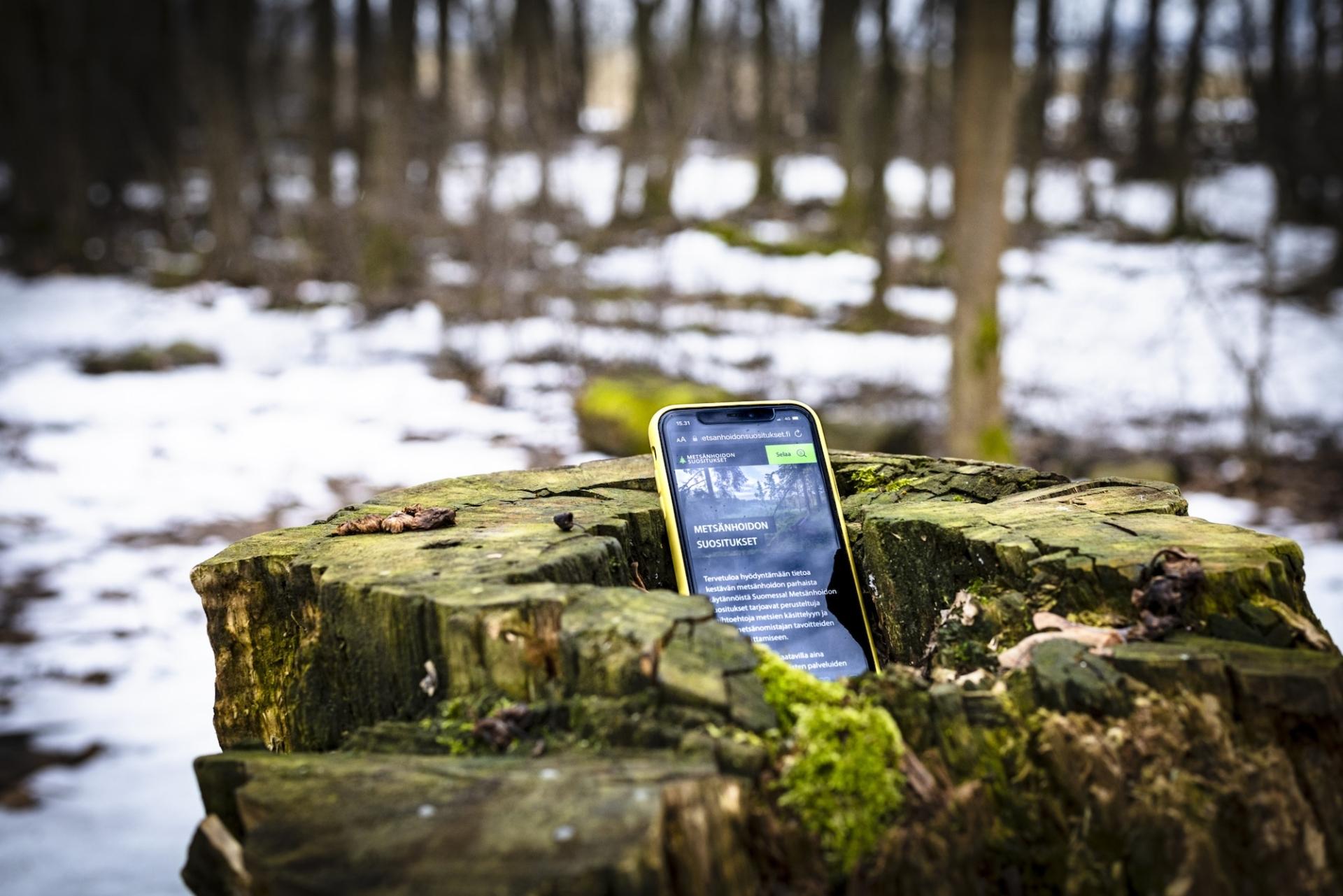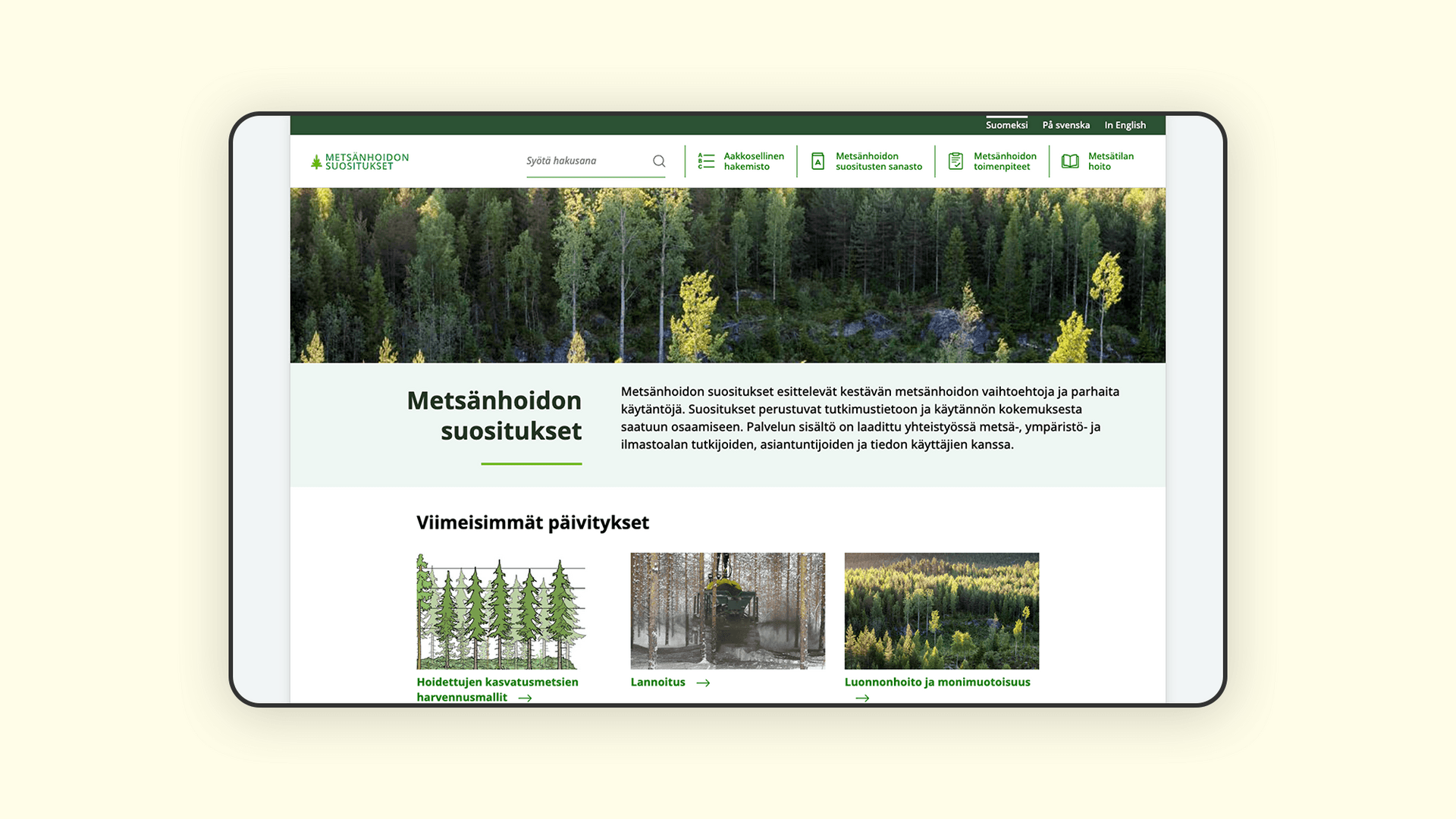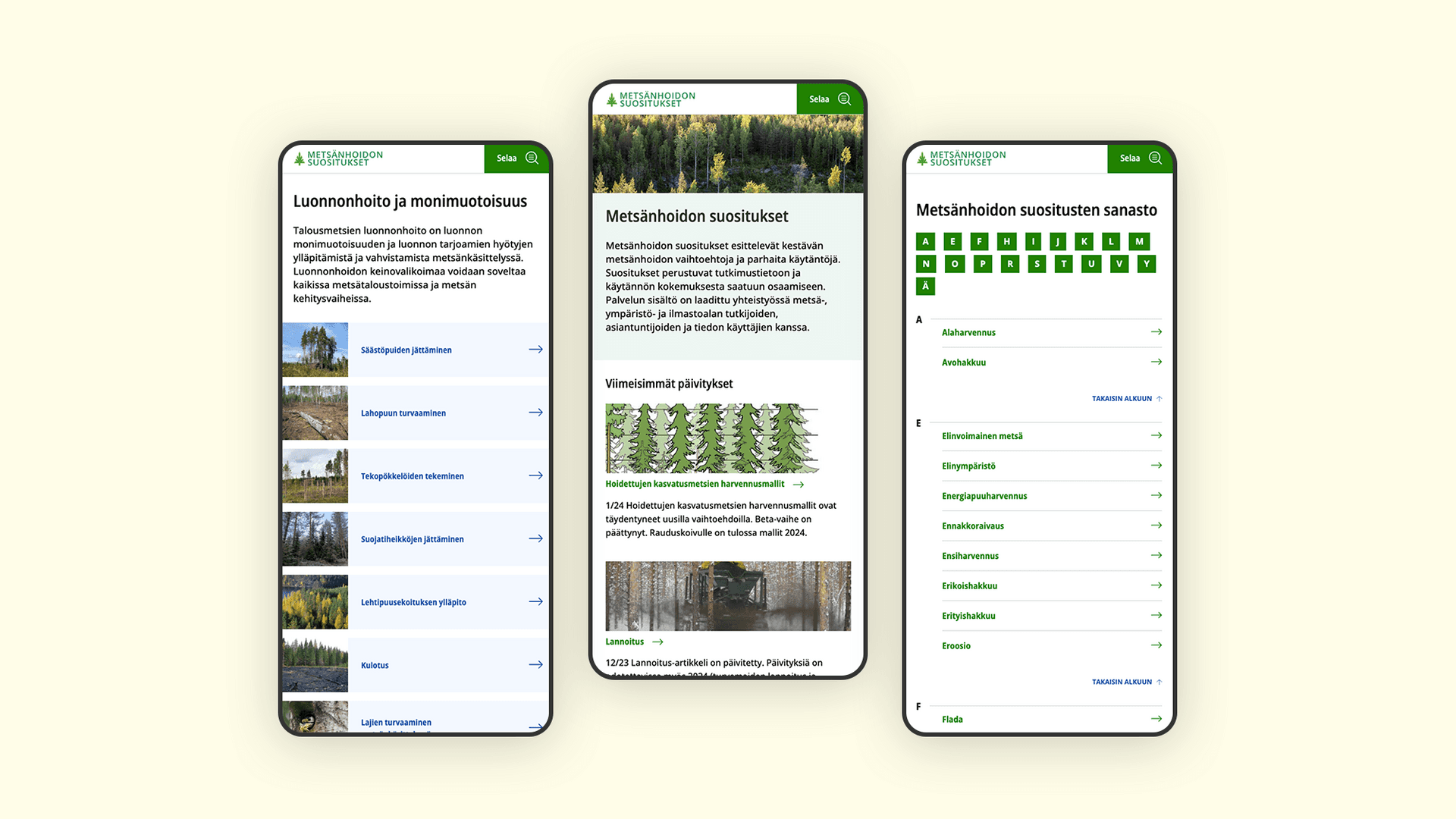Metsänhoidon suositukset - Sustainable digital solutions for Sustainable Forest Management
Sustainable digital solutions for sustainable forest management.

Briefly
The project involved transitioning Finland's "Best Practices for Sustainable Forest Management" guidelines from traditional printed manuals to the digital platform Metsänhoidonsuositukset.fi through a collaboration between Tapio and Wunder. The goal was to modernize distribution, streamline processes, and enhance accessibility while incorporating stakeholder needs. Results showed improved distribution and usability of forestry management guidelines, with stakeholders adopting more efficient methods for accessing and refining information. The collaboration successfully brought forestry management guidelines into the digital era, paving the way for continued innovation and sustainability efforts in the sector.

"We interviewed the Wunder project team during the bidding process. The interview convinced us all; it felt already then that it would be nice to start the development work with this group. The otherwise experienced project manager from Tapio was a first-timer in leading an information system project, so all the support from the service provider would be necessary - this fell into place. We felt confident at the end of the bidding process. As the collaboration started, we had positive expectations and felt we could trust Wunder."
About Metsänhoidonsuositukset.fi
Metsänhoidonsuositukset (the Best Practices for Sustainable Forest Management) is an online information service the Ministry of Agriculture and Forestry provides for Finnish forest owners and forestry industry stakeholders, including commercial entities. These guidelines present various options for forest management and offer practical advice for the implementation of actions.
The foundation of these comprehensive recommendations; developed through extensive collaboration in the forestry, environmental, and climate sectors; is based on research data and practical experiences. The guidelines aim to achieve overall sustainability and increase the well-being of the forests and from forests, following the national forest strategy.
Since 2020, the information has been produced and disseminated in digital format. The guideline is openly and freely available to everyone at www.metsanhoidonsuositukset.fiOpens in a new tab. The open interface of the information service enables the recommendations to be transferred in the desired format and scope to other information systems, including electronic services, applications, or educational materials in the forestry sector.
Goals
The project goal was to bring the recommendations and their planning into the modern era. Previously, the guidelines were available either as printed books or downloadable PDF files.
The objectives were to:
- Create a structure suitable for digitally distributing the information content of a book.
- Streamline the delivery and commenting process of the guidelines.
- Build tools suitable for digital information management.
- Implement a service where information would be available to various user groups in the required scope, both through browsers and interfaces.
It was, therefore, a digital transformation with all its numerous new possibilities.
The collaboration between Tapio and Wunder in this project began in 2019. The MVP (Minimum Viable Product) version of the digital guidelines, publishing system, distribution interface, and browser user interface were implemented according to the target schedule in 2020. A key factor in the success of the project was the open collaboration among various parties and stakeholders, as well as the trust in the multi-talented team's ability to find the right solutions for the defined needs.
The digitalization of the Best Practices for Sustainable Forest Management was expected to bring the following direct or indirect benefits:
Creating added value for users of forest information:
- Integration and upgradability to the information systems of forestry organizations through an interface
- Enabling the implementation of support services and applications that utilize forest information
- Promoting the livelihood of forest industries
- Serving and guiding forest owners with information
- Enhancing the growth and vitality of Finland's forest stock
- Strengthening the climate resilience of forest management
- Increasing the ability to manage environmental risks
Accessibility, Availability, and Timeliness of Information:
- The maintenance process becomes more agile, reducing the time spent on updates.
- The information publishing cycle accelerates, making up-to-date information more easily accessible.
- Services based on structured information can be implemented in user-friendly and simple ways.
- Digitalization allows various ways of presenting information.
- The interface enables the reuse of information in other applications.
- An accessible user interface enables barrier-free usage and ensures compliance with the EU Accessibility Directive for equally accessible services.

Challenge
From the beginning, it was clear that the project was entering new territory, and the change would be substantial. The digitalization of the guide, which had been in print since 1989, significantly impacted:
- Writing and reviewing methods of the content
- Tools used in the guide's development
- Publication cycles
- Distribution
- Data formats
- Ways of using information
The service has exceptionally diverse user and stakeholder groups, and considering and involving their perspectives was crucial for achieving a successful outcome. The challenge identified was the change generated by the transformation for numerous stakeholders and the potential difficulties in understanding the opportunities for entirely new ways of working.
At an early stage discovered challenge was successfully turned into an advantage: the stakeholders (content producers and service users) were involved in the development of the service and thus it could be taken in a direction that genuinely fulfilled their needs, making the implementation of the change easier. Service design played once again a significant role in the planning of these digital solutions: the better we understand the stakeholders' needs, the easier it is to develop and implement solutions that guide the change in the desired direction.
"During 2019-2021, the goal was to establish the system, structure the guidelines within the system, and make the interface service operational. Communication also played a significant role, aiming to encourage as many forestry industry stakeholders as possible to use the service and interface," says Kati Kontinen, Chief Specialist at Tapio.
The benefits of close and fruitful cooperation as well as transparent roles were also quite clear to the Wunderians:
"The ideas on how to effectively implement the Best Practices for Sustainable Forest Management came from the client. Wunder's task has been to innovate and implement appropriate and scalable digital solutions," says Jan Lindström, the lead developer at Wunder.
Solution
Building Blocks of Success:
Multilateral Slack Channel:
A shared Slack channel was adopted relatively early, significantly before the launch of the revamped online service. This allowed direct dialogue with forestry software experts and enabled testing of interfaces before the launch. (Services utilizing these technical interfaces include, among others, the Ministry of Agriculture and Forestry, Stora Enso, Metsä Group, UPM, Trimble Forestry, Metsäteho, Metsähallitus, Forest Management Associations, and the Finnish Forest Centre.)
Rapid Publication of Content Production Environment:
The service is hosted in Wunder's hosting environment, Silta. Thanks to Silta, a ready-to-use content production environment was live within a month - very quickly. This made it possible for the client to have an efficient and controlled adaptation to the new digital environment.
Psychological Safety:
The strong and mutual professional respect between Tapio and Wunder cannot be emphasized enough. This has enabled an exceptionally high level of innovation and has positively influenced everything done together, especially the discovery phase where the information gathered guides the direction of the overall transformation. In this project, it has been safe and even developmental to acknowledge that something is still new to oneself.
Accessibility:
Attention was also paid to accessibility, as the organization falls under the Ministry of Agriculture and Forestry, and the user groups are diverse. By investing in accessibility, the second set goal, improving search engine visibility (and thereby increasing service usage), became easier to achieve. Search engine robots crawl websites using the same logic as screen reader applications, and for example, Google prioritizes accessible websites higher in search results than those that are not accessible.
For this reason, inclusivity in the design and implementation of online services is worthwhile: it often brings in the 15 % of the population that might otherwise be excluded from the service and enhances the organic (free) visibility of the online service.
"In this project, saying 'I don't know' has meant professional development because it has allowed us to explore entirely new things. And this has enabled the development of new solutions," rejoices Jan Lindström, the lead developer at Wunder.
"Wunder's expertise in accessibility was excellent, so we effortlessly created a service that promotes digital equality in society. Accessibility brings clarity to the service, which is beneficial for all users," says Kati Kontinen from Tapio.
"The round table of the Best Practices for Sustainable Forest Management is our user community, which helps in developing the guidelines and the system so that it’s as useful and user-friendly as possible. They have not provided much feedback on the technical usability, so it seems to be working well. In one discussion, they pondered whether forestry advisors are still needed when there is such a good service – of course, they concluded that human contacts will still be needed in the future. The content producers of the Best Practices for Sustainable Forest Management have become more ambitious: a well-functioning system opens up possibilities for various new presentation formats, and ideas are in the pipeline. Users of the interface service have received a service that has been easy to adopt. The ongoing development aligns with their wishes. An example from the creators of an online course: 'It was easy to utilize the REST API with comprehensive documentation and examples, and the result turned out excellent. The interface works quickly, and the user doesn't notice separate long loading times while reading the course content,'" says Kati Kontinen from Tapio.

Results
The implementation of Decoupled Drupal, combined with the use of service design and an agile project approach, proved to be a successful recipe. The long-term and still ongoing collaboration has yielded the desired results. This is how the chief specialist of Tapio comments on the comprehensive transformation:
"The crown jewel of our operations, the Best Practices for Sustainable Forest Management, received a completely new operating model. The service was brought into the 2020s. The main goal was to improve the distribution of forestry management guidelines. Previously, the ways to share best practices were numerous PDFs and books. Now we moved into an entirely new world, with websites and interfaces. And we succeeded in that. The change has meant that we also need to adopt new ways of working and operating in the process of creating guidelines. The presentation format of Best Practices for Sustainable Forest Management has become more uniform, making them easier to use. Public information produced by Tapio can now be utilized much more extensively than before the complete revamp of the site," rejoices Kati Kontinen from Tapio.
Both the content production and site renovations, as well as the interface as an entirely new service, have all been well-received. Stakeholders utilizing the information have found new, more efficient ways to access and refine the information they need. Content editors have been inspired to consider and implement more diverse presentation formats for the data they produce.
Measuring against the performance indicators defined at the beginning, the project has proven to be truly successful. The collaboration has been good, fruitful, and inspiring, and it will continue to be that.
"The collaboration is easy and simple. The communication tools are user-friendly, and response times are short. I can warmly recommend Wunder as a partner!" says Petri Latva-Käyrä, the product owner at Tapio.
Working on this project was enjoyable, motivating, and interesting for the team at Wunder too. Alongside the fruitful and productive collaboration, many of those involved in the project deepened their already strong connection to nature.
"Good groundwork, a willingness to listen to the users, commitment to ownership, and promoting change by setting an example are choices that enable even substantial changes to succeed. Working with Tapio's project team, experts, and representatives of stakeholders has been inspiring and has opened up new perspectives on both the forestry sector and various stakeholders. During the project, my relationship with national assets changed from recreational use to becoming a forest owner. Seems that familiarizing myself with the Best Practices for Sustainable Forest Management influenced me in the desired way," reflects service designer Talvikki Rainsola on the course and impacts of the project.
Services used in this project
Sounds interesting?
Contact our expert or fill in the form below and let us contact you.
